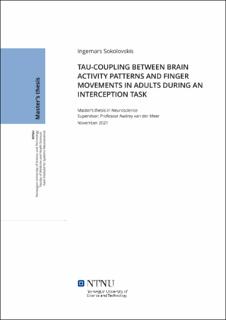| dc.description.abstract | High-density electroencephalography (EEG) was used to investigate Tau coupling between brain activity patterns and finger movements while adults were intercepting a moving target. EEG data for 12 participants were recorded with an array of 256-channel sensors. Adults were presented with an interception task which consisted of a target car, moving towards a catching area at three different speeds, and an effector dot to catch the car in the designated area with the motor movement of the finger. Tau-coupling, a part of general τ (tau) theory, helps to understand guiding movement by controlling the closure of gaps between effectors and their goals, was used in this study. By exploring the concept of resonance, on the foundation of radical embodiment, we took a closer look of dynamics of both neural and environment scale in relation to tau-coupling. Movement related potentials (MRPs) and visual evoked potentials (VEPs), and intrinsic tau-coupling were analysed. MRP and VEP analyses showed a main effect of target speed, indicating that N200 and P300 latencies for motion increased significantly with the speed of the moving object, as well as an observation of peak latencies always being longer in MRPs than VEPs. Tau-coupling analyses showed statistically significant results in slow, medium and fast speed conditions between car motion and finger movement coordinates, brain activity and car movement coordinates, brain activity and finger movement coordinates, and MRP & VEP average latency peaks. Tau-coupling analyses showed a main effect of speed, indicating that K-values of the slope increased with the speed of the moving object. It was concluded that Tau-coupling exists between visual perception, motor evoked potentials, finger movements and car movements in an interceptive timing task. | |
